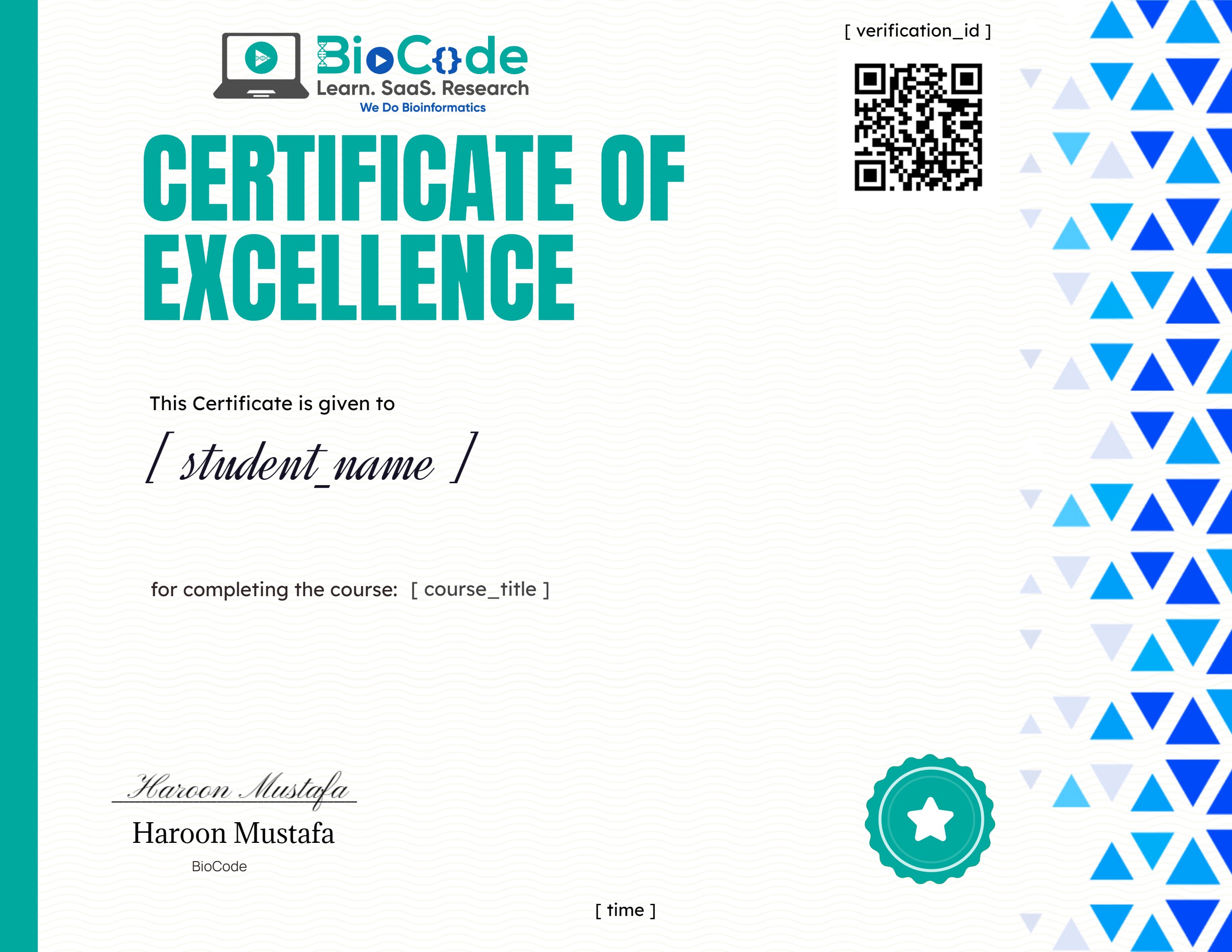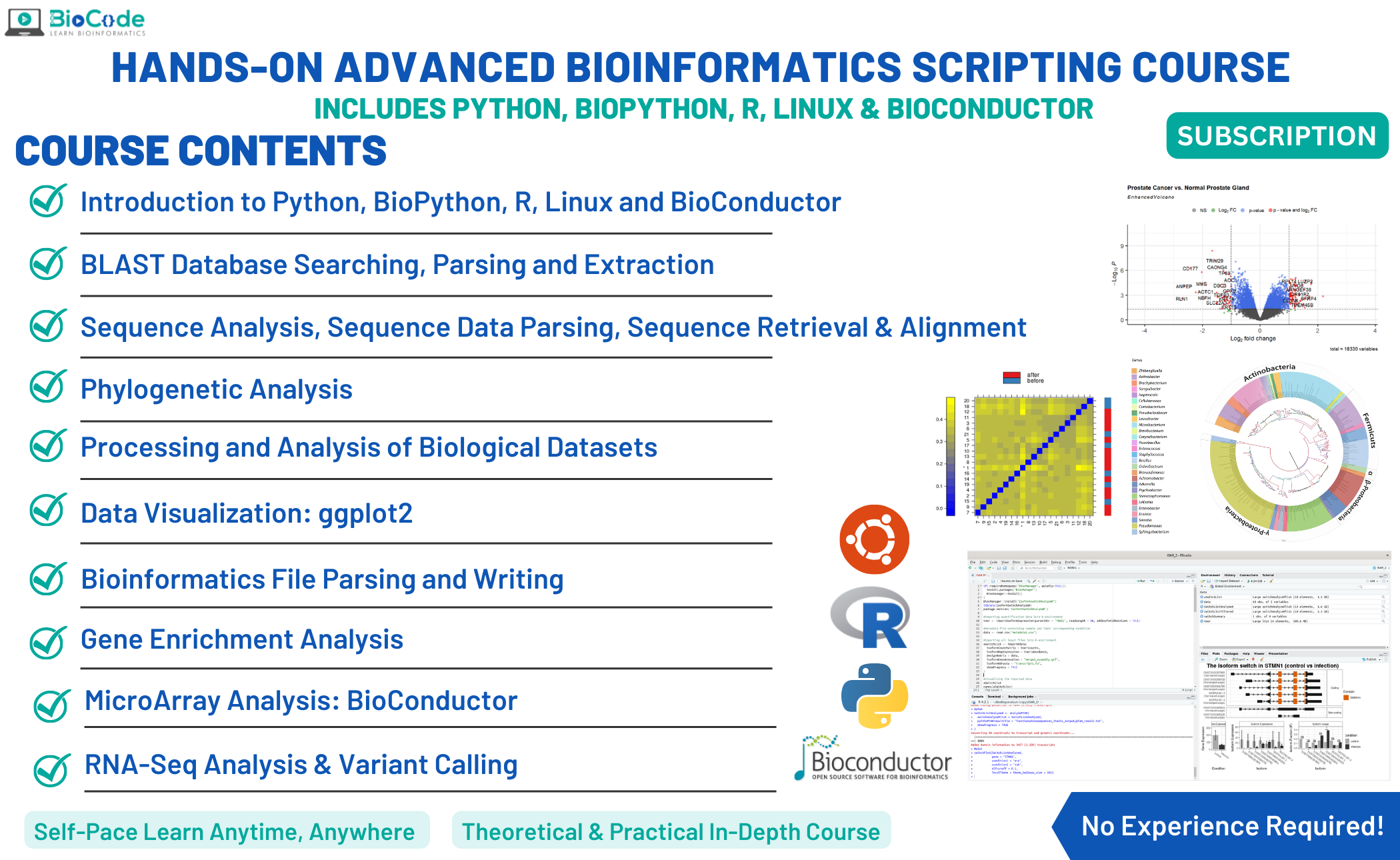Advanced Bioinformatician Course (Subscription)
About Course
Advanced Bioinformatician Course
To become an expert Bioinformatician, one must learn how to retrieve and analyze biological data in the most efficient way, to align & analyze biological sequences, to predict the evolutionary histories between them, to find out the conserved patterns, to learn how to predict coding regions or genes from a raw nucleotide sequence and 3D structure prediction of proteins to predict the functionalities of newly discovered proteins, to predict the molecular interactions for generating virtual simulations according to their molecular interactional information of a chemical/biological ligand & the receptor which aids in the identification of lead compound in drug discovery & development.
In BioCode’s Advanced Bioinformatician Course you’ll learn from the very basics of Bioinformatics analysis skills including the most commonly utilized biological databases, their features, data retrieval & analysis, to advanced MD simulation & analysis that provides detailed information about the fluctuations and conformational changes in proteins and nucleic acids. You’ll also be able to learn from the very basics of biological programming in Python, BioPython & R to an advanced level understanding of Bioinformatics Scripting, even if you lack prior knowledge.
You don’t need any prior knowledge in order to take this course. Each and everything will be taught in this course. This course is completely hands-on which means you will learn every little thing about the theoretical as well as the practical aspect of bioinformatics.
This course will include the following sections:
Section 1: Introduction to Bioinformatics Databases
Description: This section will focus on making sure that the students learn about the bioinformatics databases and data retrieval.
Learning Outcomes: Upon completion of this section, students will be able to:
- Discuss Bioinformatics Databases (NCBI, RefSeq, BLAST, UCSC Genome Browser)
- Explain Bioinformatics Sub-Databases and their functionalities.
- Retrieve all sorts of biological data from databases.
Section 2: Introduction to Bioinformatics File Formats
Description: This section will focus on making sure that the students learn about the bioinformatics file formats and how they are used.
Learning Outcomes: Upon completion of this section, students will be able to:
- Describe Bioinformatics File Formats(FASTA, GenBank, FASTQ, SAM, BAM, Clustal Omega, MEGA, PHYLIP, Stockholm etc) and where they are used.
Section 3: Introduction to Protein Databases and Analysis
Description: This section will focus on making sure that the students learn about protein databases and how to perform analysis on the retrieved protein data.
Learning Outcomes: Upon completion of this section, students will be able to:
- Explain Protein Databases (UniProt, PDB, InterPro) and their usage.
- Retrieve data from Protein Databases.
- Perform Protein Analysis.
Section 4: Sequence Alignment and Analysis
Description: In this section the students will learn how to perform sequence alignment and sequence analysis with the help of different tools.
Learning Outcomes: Upon completion of this section, students will be able to:
- Perform Sequence Alignment & Analysis using different tools.
- Perform Multiple Sequence Alignment using various tools.
Section 5: Phylogenetic Analysis
Description: In this section the students will learn how to perform phylogenetic analysis.
Learning Outcomes: Upon completion of this section, students will be able to:
- Perform Phylogenetic Analysis using MEGA.
- Perform Phylogenetic Analysis using iTOL.
- Perform Phylogenetic Analysis using FigTree.
Section 6: Secondary Structure Prediction
Description: In this section the students will learn how to perform secondary structure prediction.
Learning Outcomes: Upon completion of this section, students will be able to:
- Perform Secondary Structure Prediction using Quick 2D, Ali2D, Jpred, HHpredID, DeepCoil.
Section 7: 3D Structure Prediction
Description: In this section the students will learn how to perform 3D structure prediction.
Learning Outcomes: Upon completion of this section, students will be able to:
- Perform 3D Structure Prediction using SwissModel, MODELLER, HHPred, M4T, IntFold.
- Perform Ab initio Protein Structure Prediction using ROBETTA.
- Perform Homology Modeling using MOE.
Section 8: 3D Structure Visualization
Description: In this section the students will learn how to perform 3D structure visualization.
Learning Outcomes: Upon completion of this section, students will be able to:
- Perform 3D Structure visualization using USFC Chimera.
- Perform 3D Structure visualization using Pymol.
Section 9: 3D Structure Evaluation
Description: In this section the students will learn how to perform 3D structure evaluation.
Learning Outcomes: Upon completion of this section, students will be able to:
- Perform 3D Structure Evaluation using WhatCheck, ProCheck, ERRAT, Verify3D, RAMPAGE, SAVES.
Section 10: Molecular Docking and Docking Complex Evaluation
Description: In this section the students will learn how to perform Molecular Docking and Docking Complex Evaluation.
Learning Outcomes: Upon completion of this section, students will be able to:
- Perform Molecular Docking using MOE, SwissDock, Auto Dock Vina, ClusPro, Patchdock, PEPFOLD 3, Zdock, MdockPEP, Discovery Studio +.
- Perform Docking Complex Evaluation.
Section 11: Gene Prediction
Description: In this section the students will learn how to perform Gene Prediction using various tools.
Learning Outcomes: Upon completion of this section, students will be able to:
- Perform Gene Prediction using GeneMark, Prodigal, GenScan, AUGUSTUS.
Section 12: Protein-Protein Interaction using STRING
Description: In this section the students will learn how to perform protein-protein interaction using the STRING database.
Learning Outcomes: Upon completion of this section, students will be able to:
- Describe STRING database.
- Perform Protein-Protein Interaction on STRING database.
Section 13: Molecular Dynamic Simulation
Description: In this section, students will learn how to perform Molecular Dynamic Simulation.
Learning Outcomes: Upon completion of this section, students will be able to:
- Understand Molecular Dynamic Simulation.
- Perform all the steps needed in order to do Molecular Dynamic Simulation.
Section 14: Biological Programming Languages (Python, BioPython, R, BioConductor & Linux)
Description: In this section, students will learn from the very basics of biological programming in Python, BioPython, BioConductor & R to an advanced level understanding of Bioinformatics Scripting, even if you lack prior knowledge.
Learning Outcomes: Upon completion of this section, students will be able to:
- Install Python, R, BioPython, BioConductor and Linux.
- Declare variables, store data, implement loops and use data structures.
- Write functions in programming languages.
- Download Multiple FASTQ files using Python Script.
- Perform operations (Trimming, Alignment, Variant calling, Quantification) on FASTQ files via Python Script
Section 15: Computational Construction of Vaccines & Immunoinformatics
Description: In this section, students will first learn how to perform Target Identification. After that they will learn how to do Epitope Prediction in order to Construct Computational Vaccines.
Learning Outcomes: Upon completion of this section, students will be able to:
- Perform Target Selection.
- Remove Duplicates.
- Screen Non-Homologous Proteins.
- Screen the Antigenicity of Protein.
- Perform Linear B-cell Epitope Prediction.
- Asses linear B-Cell Epitope.
- Assess CTL Epitope.
- Predict and Assess HTL Epitopes.
Course Content
Bioinformatics Databases
-
Introduction to National Center of Biotechnology Information (NCBI)
18:02 -
Sequence Analysis
17:59 -
Sequence Retrieval from NCBI
16:17 -
PubMed Central & ENTREZ
11:07 -
GenBank: Nucleotide Database on NCBI
06:50 -
FASTA vs GenBank
18:26 -
Gene Database: A Comprehensive Gene Database
30:21 -
NCBI Genomes & NCBI Assembly: Retrieval of Genomes
36:14 -
RefSeq Database: Retrieval of Single Reference Sequences
11:16 -
BLAST Database Searching
25:37 -
Introduction to Molecular Modeling Database
08:07 -
Database of Short Genetic Variations (dbSNP)
12:16 -
HomoloGene: Discovery of Gene and Protein Families
06:11 -
Taxonomy
09:57 -
Introduction to UCSC Genome Browser & SARS-CoV-2 Viral Genome
13:40 -
Retrieve an Entire Genome & Retrieval of SARS-CoV-2 Viral Genome
09:41 -
Retrieval of Genomic Data & Annotation of SARS-CoV2 Viral Genome
05:30 -
Table Browser & SARS-CoV-2 Viral Genome
12:16 -
Visualization of Genomic Data on the Genome Browser & SARS-CoV-2 Genome
10:51 -
UniProt BLAST – Database Searching
12:33 -
UniProt Peptide Search – Find Regions Within UniProt Database
03:15 -
Introduction to ENSEMBL
07:50 -
Retrieval of a Gene-Protein-Chromosomal Region
18:02 -
Genome Assembly Retrieval and Analysis
10:24 -
Gene Analysis & Annotation
34:40 -
Variation Analysis
24:37 -
ENSEMBL BLAST/BLAT
15:08 -
Regulation – Understand the Influence of Regulatory Elements on Genes
04:19 -
Comparative Genomics Analysis
05:35 -
Introduction to Phytozome
09:39 -
Interpret Plant Genome Records
09:07 -
Download an Entire Plant Genome & Proteome
26:41 -
Keyword or BLAST Search in a Plant Genome
15:58 -
Visualize a Plant Genome Using JBrowse
17:38 -
UniProt Align – Pairwise & Multiple Sequence Alignment and Annotation
03:48 -
UniRef And Retrieve Protein Clusters
11:36 -
UniParc And Find the Non-Redundant Entries
04:59 -
Genome Reference Consortium (GRC)
07:48 -
BioProject
06:40 -
BioSystems
04:16 -
BioSample
02:56 -
Sequence Read Archive (SRA)
07:15 -
Introduction to Gene Expression Omnibus Database
09:16 -
Gene Expression Omnibus – Platforms
05:42 -
Gene Expression Omnibus – Samples
04:16 -
Gene Expression Omnibus – Series
04:01 -
Gene Expression Omnibus – Datasets
04:45
Bioinformatics File Formats
Protein Databases & Analysis
Sequence Alignment & Analysis
Phylogenetic Analysis
Secondary Structure Prediction
3D Structure Prediction
3D Structure Visualization
3D Structure Evaluation
Molecular Docking
Docking Complex Evaluation
Gene Prediction
PPI Database
Genomics Tools
Molecular Dynamics Simulation
Python
BioPython
R
Linux
R
Target Identification
Immunoinformatics Approach for Epitope Prediction
Computational Construction of the Vaccine
Evaluation
Earn a certificate
Add this certificate to your resume to demonstrate your skills & increase your chances of getting noticed.

Student Ratings & Reviews


